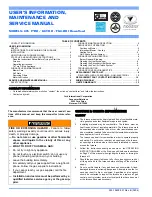
S9V2-SF-2A-EN
17
Periodic Servicing Requirements
1. GENERAL INSPECTION –
E
Ex
xa
am
miin
ne
e tth
he
e ffu
urrn
na
acce
e
iin
nsstta
alllla
attiio
on
n a
an
nn
nu
ua
alllly
y ffo
orr tth
he
e ffo
ollllo
ow
wiin
ng
g iitte
em
mss::
a. All flue product carrying areas external to the
Furnace (i.e. chimney, vent connector) are clear
and free of obstruction. A vent screen in the end
of the Vent (flue) Pipe must be inspected for
blockage annually, if applicable.
b. The vent connector is in place, slopes upward
and is physically sound without holes or
excessive corrosion.
c. The return air duct connection(s) is physically
sound, is sealed to the Furnace and terminates
outside the space containing the Furnace.
d. The physical support of the Furnace should be
sound without sagging, cracks, gaps, etc.,
around the base so as to provide a seal between
the support and the base.
2. FILTERS – Filters should be cleaned or replaced
(with high velocity filters only), monthly and more
frequently during high use times of the year such as
midsummer or midwinter.
3. BLOWERS – The Blower size and speed determine
the air volume delivered by the Furnace. The
Blower motor bearings are factory lubricated and
under normal operating conditions do not require
servicing. Annual cleaning of the Blower wheel and
housing is recommended for maximum air output,
and this must be performed only by a qualified
servicer or service agency.
4. IGNITER – This unit has a special hot surface direct
ignition device that automatically lights the
burners. Please note that it is very fragile and
should be handled with care. ! CAUTION Do NOT
touch igniter. It is extremely hot.
5. BURNER – Gas burners do not normally require
scheduled servicing, however, accumulation of
foreign material may cause a yellowing flame or
delayed ignition. Either condition indicates that a
service call is required. For best operation, burners
must be cleaned annually using brushes and
vacuum cleaner. Turn off gas and electric power
supply. To clean burners, remove burner bottom
plate (2 screws) and bottom burner bracket (2
screws). Twist burner towards slot, lift, and push
forward away from orifice. Remove burners.
Alternate method — Remove manifold assembly,
bottom burner plate, and bottom burner bracket.
Remove burners.
N
No
otte
e:: Be careful NOT to break igniter when removing
burners.
Clean burners with brush and/ or vacuum cleaner.
Reassemble parts by reversal of the above
procedure.
N
No
otte
e:: Natural gas units should not have any yellow
tipped flames. This condition indicates that a
service call is required. For best operation,
burners must be cleaned annually using brushes
and vacuum cleaner
N
No
otte
e:: On Propane units, due to variations in BTU
content and altitude, servicing may be required
at shorter intervals.
6. HEAT EXCHANGER/ FLUE PIPE – These items must
be inspected for signs of corrosion, and/ or
deterioration at the beginning of each heating
season by a qualified service technician and
cleaned annually for best operation. To clean flue
gas passages, follow recommendations below:
a. Turn off gas and electric power supply.
b. Inspect flue pipe exterior for cracks, leaks, holes
or leaky joints. Some discoloration of PVC pipe
is normal.
c. Remove door from Furnace.
d. Inspect around insulation covering flue collector
box. Inspect induced draft Blower connections
from recuperative cell and to the flue pipe
connection.
e. Remove burners. (See 5. Burner)
f.
Use a mirror and flashlight to inspect interior of
Heat Exchanger, be careful not to damage the
Igniter, Flame Sensor or other components.
g. If any corrosion is present, the Heat Exchanger
should be cleaned by a qualified service
technician.
h. After inspection is complete replace burners
and Furnace door.
i.
Restore gas supply. Check for leaks using a soap
solution. Restore electrical supply. Check unit
for normal operation.
7. COOLING COIL CONDENSATE DRAIN - If a cooling
coil is installed with the Furnace, condensate drains
should be checked and cleaned periodically to
assure that condensate can drain freely from coil to
drain. If condensate cannot drain freely water
damage could occur. (See Condensate Drain in
Installer’s Guide.)
















































